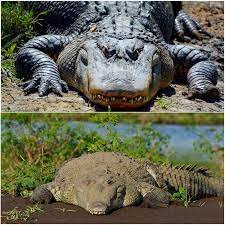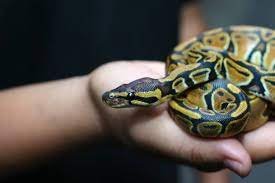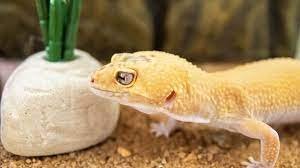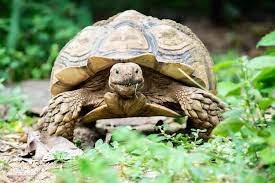Turtles are fantastic pets since they are cute as a button, low maintenance, and more engaging than, say, a fish. However, there are times when many who like turtles wish that their humongous pets might somehow shrink back to their former, more manageable sizes (not that being big changes that, though).
Red-Eared Slider Turtle

Pet Red Eared Slider turtles are a popular species of a turtle because of their popularity and the fact that they are native to North America. The red patches around their ears are what give these reptiles their distinctive “red-eared” moniker, though.
European Pond Turtle
The European pond turtle, or Emys Orbicularis as it is known in Latin, is a friendly freshwater turtle species. These critters are extremely resilient and tolerant of bland omnivorous fare.
Spotted Turtles

The southeastern United States and Canada are both good places to look for spotted turtles. In spite of their little (just 5 inches long), they make excellent pets because of their size-specific cuteness and curiosity. A spotted turtle is easily identified by the yellow-cream patches that cover its otherwise black or dark-brown body.
African Sideneck Turtle
Unlike other kinds of aquatic turtles, these tiny creatures can’t entirely retract their lengthy necks into their shells.
Bog Tortoise

The bog turtle, or Glyptemys muhlenbergii, is another popular pet turtle in the USA. While native to the eastern United States, these little turtles thrive in captivity and frequently become tame, friendly pets.
Loggerhead musk turtle
North America is home to a small freshwater turtle known as the loggerhead musk turtle (Sternotherus minor). This species of turtle is well-known for its low maintenance requirements and the fact that some individuals when kept in captivity for an extended period of time, become extremely tame.
Chinese box turtle

Central China, some of Japan, and Taiwan are all home to Chinese box turtle populations. These stunning semiaquatic turtles are easily identifiable by the bright yellow edges that run over their undersides. Their dark brown, extremely dome-shaped shells are accented by bright yellow stripes along their keels.
Pink belly side neck turtle
Originally from Papua New Guinea and Australia, the pink-belly side-neck turtle does quite well in captivity. Keep several pink-belly side-neck turtles at once, since they thrive when allowed to socialize with one another.
Ouachita Map Turtle
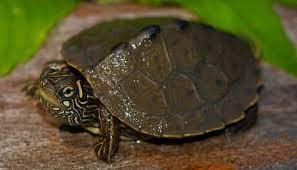
Graptemys ouachitensis, often known as the ouachita map turtle, is a tiny freshwater turtle endemic to the Mississippi River basin in North America. Because of their resilience and ability to adjust to captivity, they are frequently recommended as first turtles.
Malaysian Box turtle
The Southeast Asian Box turtle, often called the Amboina Box turtle, includes the Malaysian Box turtle as a subspecies. Some of the countries in Indochina that are home to this subspecies are Malaysia, Singapore, Thailand, and Vietnam.
Northern Map Turtle

Sometimes referred to as “Common Maps,” northern Map Turtles are a subspecies of the Map Turtle. They’re more popular as pets than the Ouachita Map breed despite being just as low maintenance. The range of Northern Maps is exceptional all the way to eastern North America.
Coahuilan Box Turtle
When it comes to Box turtles, the Coahuilan is the most vulnerable. Because of their limited distribution, they are only found in the Coahuila region of Mexico, specifically in the area around the city of Cuatro Cienegas. The Coahuilan Box turtle, in contrast to virtually all other Box turtles, spends nearly all of its time in the water.
Desert box turtle

The desert box turtle, or Terrapene ornata as it is known in Latin, is another land-dwelling turtle species that makes a great first pet. Although it can reach a maximum adult size of 6 inches, the desert box turtle makes a great companion because of its tiny size and calm demeanor.
Eastern box turtle
Large enclosures are required for eastern box turtles, although these turtles are surprisingly versatile. If housed indoors, they require a humid climate, a UVB basking lamp, a moist substrate, and a shallow pool of water.
Western-painted turtle

If you’re searching for a turtle with personality and style, a Western-painted turtle can be a good option. There have intricate designs on their shells. These aquatic turtles may not be very enormous, but they do require a large tank or outdoor space, a reliable water filtration system, and basking lights to keep them toasty.
Mud turtles
Without Mud turtles, which reach a maximum adult size of only 4 to 5 inches, the list would be severely lacking in diversity. The mud turtle is a native of Africa, Mexico, and even areas of North America. The two most well-known species of mud turtles, the infamous mud turtle and the striped mud turtle, both reach a maximum adult size of about 4.5 inches.
Mata Mata Turtle
The Mata Mata is one of the most unusual-looking of these species. Their unique design is a big draw for first-time pet owners. The ridges on their shells look like those of an alligator, and they can be a variety of bright colors, including red, brown, and green.
Gulf Coast Box turtle

The Gulf Coast Box turtle, measuring up to 8.5 inches in length, is the largest of the Common Box turtle subspecies. They inhabit the estuaries, swamps, and brackish waters of the Gulf of Mexico. This species’ semi-aquatic lifestyle necessitates the presence of warm, humid conditions.
Ornate Box Turtle
This species of turtle, known as the Ornate Box Turtle, is stunning to behold. Their dark brown or black shells are patterned with yellow to orange stripes, making them very recognisable. Throughout much of the central and western United States lives the Ornate Box turtle, the state reptile of Kansas.
Three-toed Box Turtle
Those parts of the United States central and south are home to a subspecies of the Eastern Box turtle known as the Three-toed Box turtle. Missouri’s official reptile is the Three-toed Box turtle. These turtles are highly adaptable to changes in their environment, and they are equally at home in grassy meadows as they are in wooded places.
Reeve’s turtle
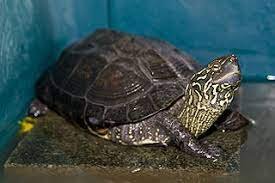
Reeve’s turtle is also called the Chinese Pong turtle by others. The people of China, Japan, and Taiwan love keeping these turtle species as pets. Lands with plenty of greenery and places to sun themselves are ideal habitats for reeve turtles, thus lakes, ponds, and slow-moving streams are where you’ll most likely find one.
Chinese softshell turtle
In addition to China, Thailand, Japan, Korea, and Vietnam all have populations of the Chinese softshell turtle. Named for their comparatively pliable shells, these creatures are anything but hard-bodied. The softshell turtle, like the Mata Mata, is a very rare species.
Florida Softshells
Originally from the eastern United States, namely the state of Florida, is where you’ll find the most Florida Softshells. Caring for a soft-shelled turtle is pretty much the same regardless of species.
Smart, adorable, and loads of fun, these turtles are a must-have. They require a large body of water in which to swim and a relatively modest basking area, much like the Chinese Softshell.
Spiny Softshell Turtle
Good news for those just starting out with turtles as pets! The spiny softshell turtle is a great choice for a pet if you want a long-lived animal that will provide you with the company for a good portion of your life. You may rest assured that your pet will be with you for a very long time because these wary turtles can survive for over 50 years in captivity!
Chicken Turtles

There are two distinct species of chicken turtles found in the United States: eastern and western chicken turtles. Both of these animals are only fully aquatic when in the slow-moving waters of a lake or pond. The delicious flavor of chicken turtle meat earned them the appellation “chicken turtles” in the South.
Yellow Mud Turtle
What a peculiar creature, the yellow mud turtle! Animals of this type are primarily carnivorous, however, they do occasionally indulge in a vegetarian feast of duckweed.
In what ways does this affect the prospects of people who want to buy one of these exotic animals as a pet? You may give them a variety of protein-rich foods, from earthworms and crickets to feeder fish, shrimp, and even beef hearts.
Eastern River Cooter
Semiaquatic freshwater Eastern River Cooters are widespread across the East and Midwest of the United States. It is not uncommon to spot them sunbathing on rocks or logs along the water’s edge. The fast-moving waters of lakes, rivers, and streams are perfect for these medium-sized turtles, which can also breathe underwater.
Florida River Cooter
Species of the genus Cooter can be found all over the world, however, the Florida Red-bellied Cooter can only be found in Florida and some of Georgia. These medium-sized Cooters are easily identified by their bright red plastrons, which gradually fade as the birds reach maturity. Their shells are brown and domed, and they are striped with yellow.
Diamondback Terrapin Turtle
The diamondback terrapin turtle is one of the most interesting marine reptiles. These creatures originated in the southern United States and thrive in hot and humid conditions. This implies their keepers should aim for a constant enclosure temperature of about 80 degrees Fahrenheit.
Peninsular Cooter
A close relative of the Coastal Plains/Florida Cooter, the Peninsular Cooter is found only in the Florida Peninsula and can live in any body of water. The Peninsular Cooter is distinguished by its yellowish plastron and a body pattern of yellow stripes. The Peninsular Cooter, like other species of Cooter, is a herbivore that subsists on submerged plants.
Also, know about Russian Tortoise Care Sheet, Diet, Habitat & Enclosure
False Map Turtle
Another species of aquatic turtle native to North America. G. The common name for the false map turtle is Pseudemys pseudogeographica. The Mississippi map turtle is one of the two other subspecies of fake map turtles. Their names come from the fact that the lines on their bodies and shells mimic contour lines on a map, hence the name “map turtles.”
Even for a little turtle, they are on the diminutive side. It’s important to note that females are considerably larger than males. A male will thrive in a tank as small as 20 to 25 gallons, but a robust female will require at least 75 gallons.
Golden Thread Turtle
The Golden Thread Turtle is only found in China, Laos, Taiwan, and Vietnam, all of which are in Asia. In order to survive, this endangered species needs calm, lowland rivers. Their diet is varied and includes both plant and animal matter, with age influencing the proportion of plant matter consumed.
Indian Tent Turtle
The Indian Tent Turtle is a tiny, semiaquatic reptile found naturally only in India and Bangladesh. Their tent-shaped shells are what give them their common name, and they are often a dark brown color. The shells of Indian Tent turtles are pink and feature reddish spots behind the eyes.


